What makes Death Valley unique? Extreme weather conditions characterize the area – but the diversity of color and texture, in a place that seems at first as dead as its name, is absolutely stunning. Death Valley is truly a landscape photographer’s paradise. Beautiful skies, incredible textures, and intense colors provide inspiration wherever you go. But landscape photography requires more than inspiration – it’s hard work.
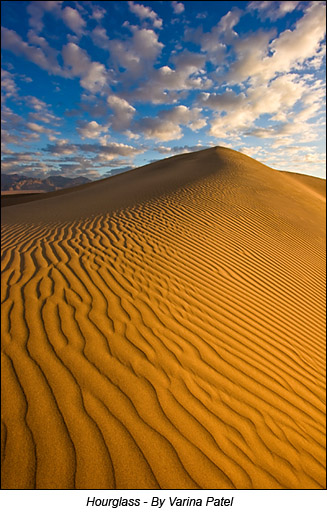
Most photographers know that the light is best early in the morning or late in the evening. The Mesquite dunes at Stovepipe Wells are magnificent at any time of day, but that “golden hour” glow highlights the dramatic textures in the sand. We have visited the dunes many times in the past few years, and we always rise early in order to capture the best light. We climb the ever-shifting dunes in the dark and hike beyond the footprints of other visitors. As the sun rises over the mountains in the distance, it paints the sand with a deep orange light. We watch the skies carefully to increase our chances of success… waiting for impressive clouds that reach to the horizon.
On one occasion, Jay found himself in the midst of a sandstorm. He huddled in the wind, trying to protect his eyes and his camera from the stinging sand – and hoping the sky would open up. At last, a beam of light pierced the clouds behind him, and the distant dunes were bathed in evening light. His camera survived the experience – though it needed a good cleaning when he returned home – and the resulting photograph was well worth the effort.
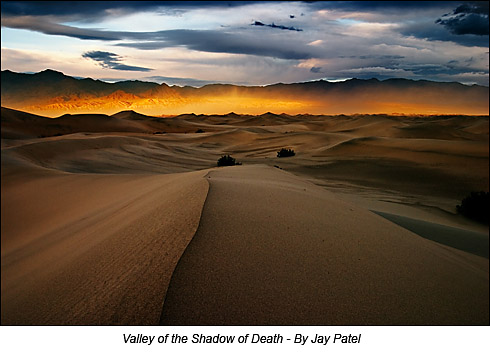
Another favorite destination is the Racetrack. This bizarre landscape is as difficult to access as it is to believe. Two hours in a four-wheel drive vehicle on a dirt road bring you to the edge of a cracked and dry lakebed that stretches into the distance. The first glimpse of the Racetrack is impressive, but it isn’t until you set out on foot that you can truly appreciate its enormity. We walked more than two miles to reach the stones we chose to photograph.
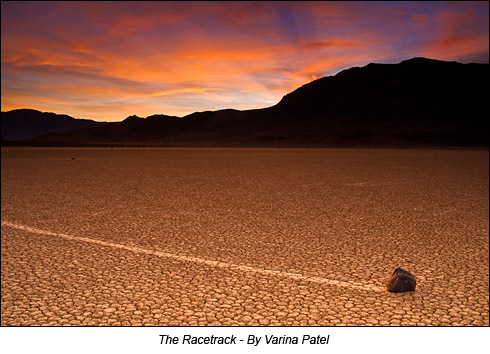
There is more to the Racetrack than the vast playa with its striking textures. A combination of extreme conditions – 70 mile an hour winds, sweltering heat during the day, and freezing nighttime temperatures in winter – make possible a unique natural phenomenon. Here, the rocks move by themselves. They leave tracks – telltale signs of their wanderings in the otherwise flat lake bed. Although several theories exist to explain their movement, the fact is that to this day no human has ever witnessed the rocks in motion.
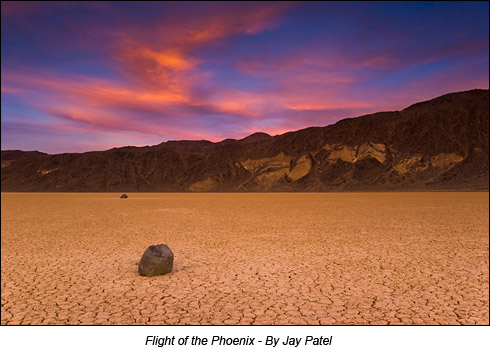
On another morning, we left the warmth of our beds at 4am and headed towards the salt flats. As we drove, we watched the sky brighten in the East. We feared that we would arrive too late for the sunrise. Being careful not to damage the fragile crystalline formations, we ran nearly a mile onto the dry playa. We set up our tripods just in time. We have been to this location more than once, and been disappointed – sometimes a storm will wash the beautiful patterns away, leaving the salt flats… well… flat. At other times, the sky is dull and the light uninteresting. But, when everything is right, the location is spectacular. Repetitive hexagonal patterns formed by evaporation and the formation of salt crystals rise in relief across the clean, white playa.

The Devil’s golf course is, perhaps, the most bizarre location of all. Like the salt flats, evaporation has created a unique landscape, but here, constant fluctuations in moisture levels have pushed the salt formations upward. They form a prickly landscape that stretches towards the mountains in the East and West. We timed one visit to catch the rising of a full moon. As the sun set behind us, a bright moon rose over the mountains in the East. We photographed the land using a wide angle lens and a long exposure to compensate for the darkness. Then, just a few seconds later, we replaced the wide angle lens with a zoom lens and photographed the moon. Later, we combined the two images in Photoshop using a “double exposure” technique borrowed from the days of film photography.
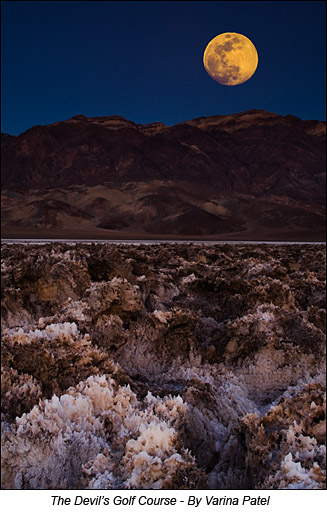
Photographing Death Valley is an incredible experience, but a few days is never enough. The park stretches across 3 million acres of rocky wilderness, and is the largest park in the lower 48 states. Rolling dunes and cracked playa reside alongside mountains and volcanic craters. The desert even hides a waterfall deep in one of its narrow canyons. Landscape photography in Death Valley is far more than art. It takes planning, determination, luck – and hard work. But in the end, the final image – if you can get it just right - is worth every aching muscle and every drop of sweat.
Tips For Photographing Death Valley
- Summer temperatures in Death Valley regularly climb above 110 degrees Fahrenheit, so plan your trip for cooler weather. Winter is the perfect time to visit. Winter storms bring impressive cloud formations as well.
- Be prepared for cold nights. Although daytime temperatures are high even in winter, it gets cold once the sun drops below the horizon. If you intend to be out after sundown, wear layers and bring gloves that allow you to work the controls of your camera without taking them off.
- Plan your trip so that you can make the most of your time. Photograph flat locations like the Devil’s Golf Course, the Racetrack, and the salt flats at sunrise or sunset. Low light makes the most of the fantastic textures on the ground. When the sun is high, scout for your next shot - or shoot in the canyons. At noon in the winter, Darwin Falls is still in shade.
- Storm lighting can be spectacular at any time of day – but storms can be dangerous, so keep an eye on the weather all the time. Check local weather before your trip so you know what to expect.
- Make sure you have a good map so you don’t get lost and leave plenty of time for driving from one location to the next – Death Valley is a very big place.
- A four-wheel drive vehicle is necessary if you want to visit some of the remote parts of the park. Although the main roads are well maintained, you will find that back roads are pretty rough. Be prepared to be bumped around.
- Get to your shooting location early so you have time to explore before the light show begins. Look for foreground objects that will make your shots more interesting, and try to find a variety of compositions that you can shoot in a short period of time. It only takes a few minutes for the colors in the sky to fade, so be ready for them.
- Don’t bring gear you don’t need on long hikes – use the extra space to stock up on water and snacks. You don’t want to be stuck out there with nothing to drink. Leaving behind your second camera won’t kill you – forgetting your water just might. Cell phones don’t work in the middle of the desert, so don’t count on being rescued.
- Keep a Graduated Neutral Density (ND Grad) filter handy for sunrise and sunset. Use it to reduce the brightness of the sky. This ensures that details are captured in both dark and light areas.
Comments on NPN landscape photography articles? Send them to the editor.
Varina and Jay Patel are landscape photographers committed to capturing wild places at their best. They seek to photograph stunning landscapes against spectacular skies, and are willing to handle extreme weather conditions, strenuous hiking trails, and long periods of waiting in order to meet that goal.
More of their work can be seen at www.photographybyvarina.com and www.jaypatelphotography.com.